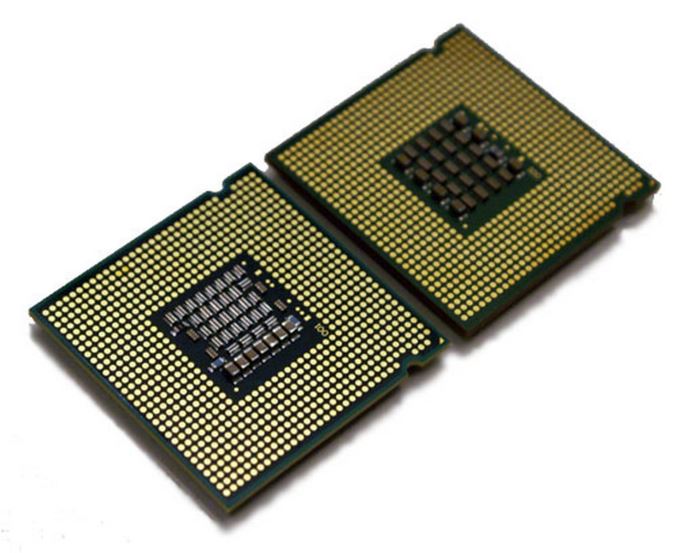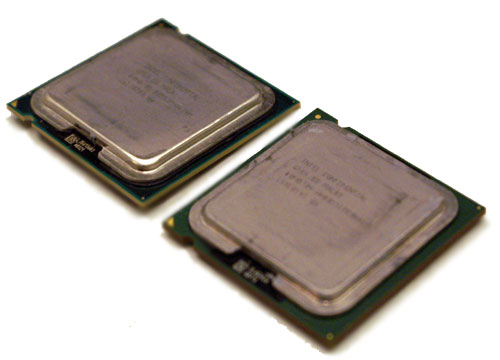Ten Year Anniversary of Core 2 Duo and Conroe: Moore’s Law is Dead, Long Live Moore’s Law
by Ian Cutress on July 27, 2016 10:30 AM EST- Posted in
- CPUs
- Intel
- Core 2 Duo
- Conroe
- ITRS
- Nostalgia
- Time To Upgrade

Today marks a full 10 years since the first Core 2 Duo processors, and hence Intel’s 64-bit Core microarchitecture, were made officially available at retail. These included a number of popular dual-core processor parts, including the seemingly ubiquitous E6400 and the Core 2 Extreme X6800. These were built on Intel’s 65nm process, and marked a turning point in the desktop processor ecosystem. To quote Anand in our launch review: ‘you’re looking at the most impressive piece of silicon the world has ever seen’.
Ten Year Anniversary of Core 2 Duo and Conroe
As part of this piece we will also look at some of the predictions for the future, from the latest (and possibly last) International Technology Roadmap for Semiconductors report, which predicts the stalling of smaller silicon manufacturing nodes over the next 10-15 years.
The first part of this article borrows heavily from Johan’s original look into the Intel Core microarchitecture back in 2006. It’s an awesome read.
Back When I Were A Lad
For a number of our readers, the launch of Conroe was a vast change in the processing landscape. The family of Netburst, Northwood and Prescott processors, in the form of Pentium D and Pentium 4, showed that pursuing the frequency race pushed the silicon far outside its efficiency zone and left a hot, power hungry mess in its wake. It didn’t even come with a muscular V8 sound, and AMD’s Athlon 64 X2 line had taken both the performance and efficiency crown.

Core 2 Duo (left) vs Pentium D (right)
From the perspective of Intel, it had to incorporate a significant paradigm shift in the way it approached the core microarchitecture – no more long pipelines to bump up clock rates to start. The Core microarchitecture design was marketed as a blend of Pentium Pro and Pentium M techniques, as well as the Netburst architecture, however as Johan pointed out at the time, it is significantly Pentium M and it is very hard to find anything Netburst in there. It wasn’t as simple as ‘adding a few functional units or decoders on Yonah and calling it a day’, almost 80% of the architecture and circuit design had to be redone.
As part of this piece, we’re going to take another look at the original architecture improvements of the Core microarchitecture design and some of our old performance metrics from a decade ago.
27th July 2006: Core 2 Launch Day
Ten years ago, Intel launched the following five processors:
| CPU | Clock Speed | L2 Cache |
| Intel Core 2 Extreme X6800 | 2.93GHz | 4MB |
| Intel Core 2 Duo E6700 | 2.66GHz | 4MB |
| Intel Core 2 Duo E6600 | 2.40GHz | 4MB |
| Intel Core 2 Duo E6400 | 2.13GHz | 2MB |
| Intel Core 2 Duo E6300 | 1.86GHz | 2MB |
The X6800 sits at the top with a higher clock speed with a higher supported FSB-to-core ration than previous Intel processors. The Core 2 processors all came from a 143mm2 die, compared the 162mm2 of Pentium D, and they both seem tiny by comparison to the large die sizes we see 2016 for things like the P100. These were chips without integrated graphics either. The introduction of Core 2 pushed the prices of the Pentium D processors down, to give this interesting table:
| CPU | Clock Speed | L2 Cache | Price |
| Intel Core 2 Extreme X6800 | 2.93GHz | 4MB | $999 |
| Intel Core 2 Duo E6700 | 2.66GHz | 4MB | $530 |
| Intel Core 2 Duo E6600 | 2.40GHz | 4MB | $316 |
| Intel Core 2 Duo E6400 | 2.13GHz | 2MB | $224 |
| Intel Core 2 Duo E6300 | 1.86GHz | 2MB | $183 |
| Intel Pentium D 945 | 3.40GHz | 2MBx2 | $163 |
| Intel Pentium D 915 | 2.80GHz | 2MBx2 | $133 |
| Intel Pentium D 820 | 2.80GHz | 1MBx2 | $113 |
| Intel Pentium D 805 | 2.66GHz | 1MBx2 | $93 |
Comparing this to recent Intel processors, and the X8600 matches the list price of the Core i7-5960X (an 8-core part), whereas the popular Core 2 Duo E6400 at $224 at the same price as the Core i5-6600.
A few years ago, I salvaged a super old computer of mine with an E6400 and took it for a spin for a pipeline piece entitled ‘Dragging Core 2 Duo into 2013’. We know that a number of users today are still using the old platform as their day to day machine, and given that it is now celebrating its 10th birthday, it is interesting that anyone wanting to play around with the old hardware can get a motherboard, memory and CPU from eBay for $50-70.
My crusty C2D Setup from 2013











158 Comments
View All Comments
Dobson123 - Wednesday, July 27, 2016 - link
I'm getting old.3ogdy - Wednesday, July 27, 2016 - link
That's what I thought about when I read "TEN year anniversary". It certainly doesn't feel like it was yesterday...but it certainly feels as old as "last month" is in my mind and that's mostly thanks to i7s, FXs, IPS, SSDs and some other things that proved to be more or less of a landmark in tech history.close - Thursday, July 28, 2016 - link
I just realized I have an old HP desktop with a C2D E6400 that will turn 10 in a few months and it's still humming along nicely every day. It ran XP until this May when I switched it to Win10 (and a brand new SSD). The kind of performance it offers in day to day work even to this day amazes me and sometimes it even makes me wonder why people with very basic workloads would buy more expensive stuff than this.junky77 - Thursday, July 28, 2016 - link
marketing, misinformation, lies and the need to feel secure and have something "better"Solandri - Friday, July 29, 2016 - link
How do you think those of us old enough to remember the 6800 and 8088 feel?JimmiG - Sunday, July 31, 2016 - link
Well my first computer had a 6510 running at 1 MHz.Funnily enough, I never owned a Core 2 CPU. I had an AM2+ motherboard and I went the route of the Athlon X2, Phenom and then Phenom II before finally switching to Intel with a Haswell i7.
Core 2 really changed the CPU landscape. For the first time in several years, Intel firmly beat AMD in efficiency and raw performance, something AMD has still not recovered from.
oynaz - Friday, August 19, 2016 - link
We miss or C64s and AmigasArtShapiro - Tuesday, August 23, 2016 - link
What about those of us who encountered vacuum tube computers?AndrewJacksonZA - Wednesday, July 27, 2016 - link
I'm still using my E6750... :-)just4U - Thursday, July 28, 2016 - link
I just retired my dads E6750. It was actually still trucking along in a Asus Nvidia board that I had figured would be dodgy because the huge aluminum heatsink on the chipset was just nasty.. Made the whole system a heatscore. Damned if that thing didn't last right into 2016. Surprised the hell out of me.